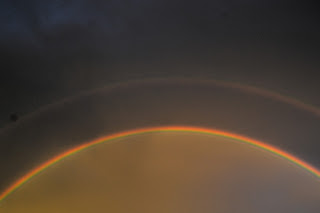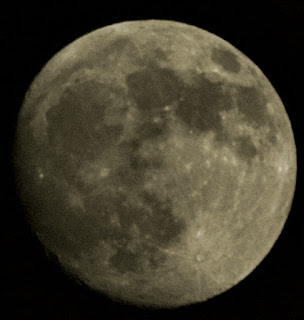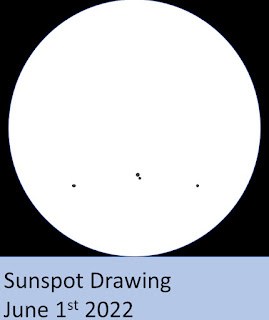June 26th 0105 GMT Deep Sky
and Planets
I swapped my wide field zoom lens with my
telephoto zoom lens. I started off with Melotte 20 at 70mm focal length, ISO
6400 and 6 seconds exposure.
Saturn was around, although my initial
aim missed it and caught some star fields.
When there, I tried to capture Titan at
300mm focal length, ISO 6400 and 2 seconds exposure. I captured Saturn and as satellite trail but no sign of Titan.
I then tried the planet, at various
exposures, more in hope than expectancy!
Jupiter had risen and I repeated the
moon shot and caught 3.
Finally, although dawn had already
broken, I took a few more shots of Melotte 20 at 300mm focal length, ISO 6400
and 2 seconds exposure.
June 26th 0010 GMT Meteor Hunt
There was no reason to suspect that there
would be any more meteors in the east than anywhere else but regulars to my
blog and photo album will know that I obtain constellation images as
by-products of meteor searches. So, I set up my camera and intervalometer in
the direction of Cassiopeia and hoped.
My hopes were dashed. No meteors and the stars were out of focus.
June 25th 1040 GMT Sun
There was a lot of moving cloud but I
managed to catch the Sun in a patch of clear sky. Feeling that some of my
recent shots had been overexposed, I used my DSLR and filter at 300mm focal
length, ISO 100 and 1/4000 second exposure.
June 25th 0015 GMT Deep Sky:
Cygnus
Sometimes astronomy can throw up
unexpectedly good surprises as well as the bad ones. After a cloudy and wet
day. I was expecting to do little more than process photos from June 11th.
Although most of the sky was cloudy, the area around Deneb in Cygnus was clear.
I took two sets of frames, one at 70mm focal length, ISO 6400 and 8 seconds
exposure and the other at 300mm focal length, ISO 6400 and 2 seconds exposure.
For the second set of frames, I shot some dark frames.
Another unexpected bonus turned up when a meteor passed close to Deneb.
The first set of frames at 70mm focal length brought out the North America Nebula.
June 23rd 0615 GMT Moon and Sun
The Moon was
at a waning crescent phase and I photographed it with my DSLR at 300mm focal
length, ISO 400 and 1/125 second exposure.
Well that's what happens when you get a large processing queue. I did not realise that I was overexposing the Moon so much. As it happened, my solar shots were also over-exposed.
I photographed
the Sun with my DSLR and filter at 300mm focal length, ISO 100 and 1/2000
second exposure. I did not get any in focus.
June 22nd 0510 GMT Moon and
Sun
I snapped the waning crescent moon with
my DSLR at 300mm focal length, ISO 400 and 1/160 second exposure. Unfortunately, the photos were overexposed.
I followed up with the Sun, using my
filter at 300mm focal length, ISO 100 and 1/2000 second exposure.
June 21st 0625 GMT Moon and
Sun
I snapped the Moon with my DSLR at 300mm
focal length, ISO 400 and 1/100 second exposure. The images were over-exposed and I could not see the Moon on any of them.
I followed up with the Sun
with a filter at 300mm focal length, ISO 100 and 1/2000 second exposure.
June 20th 0515 GMT Moon and
Sun
After a wet weekend, I snapped the waning
gibbous moon with my DSLR at 300mm focal length, ISO 400 and 1/200 second
exposure.
I then added a filter to
snap the Sun at 300mm focal length, ISO 100 and 1/2000 second exposure.
June 19th Double Rainbow
I caught a rare double rainbow from home.
June 18th 0105 GMT Moon
The Moon was low in the sky and it was
rather murky. I did not feel like staying up much later, so I tried a few shots
with my DSLR at various settings.
Just to show that not everything goes right for even experienced astronomers, all shots were out of focus, resulting in a wasted night.
June 18th 2310 GMT Meteor Hunt
Conditions were hazy, with light cloud,
and it never gets properly dark in the UK near the summer solstice. I could
finally see the Plough after checking the sky for over an hour. I aimed my
camera there, hoping for some constellation shots, even if I did not catch any
meteors. As it turned out, I had set the camera at the wrong focal length and the focus was out: very out!
June 17th
0635 GMT Sun
I arrived at
work and photographed the Sun with my DSLR and filter at 300mm focal length,
ISO 100 and 1/2000 second exposure. I was able to see a sunspot in the camera
viewfinder, so omens were good.
June 16th
0655 GMT Sun
I did another
solar shoot with my DSLR and filter at 300mm focal length, ISO 100 and 1/2000
second exposure.
June 26th 0105 GMT Deep Sky
and Planets
I swapped my wide field zoom lens with my
telephoto zoom lens. I started off with Melotte 20 at 70mm focal length, ISO
6400 and 6 seconds exposure.
Saturn was around, although my initial
aim missed it and caught some star fields.
When there, I tried to capture Titan at
300mm focal length, ISO 6400 and 2 seconds exposure. I captured Saturn and as satellite trail but no sign of Titan.
I then tried the planet, at various
exposures, more in hope than expectancy!
Jupiter had risen and I repeated the
moon shot and caught 3.
Finally, although dawn had already
broken, I took a few more shots of Melotte 20 at 300mm focal length, ISO 6400
and 2 seconds exposure.
There was no reason to suspect that there
would be any more meteors in the east than anywhere else but regulars to my
blog and photo album will know that I obtain constellation images as
by-products of meteor searches. So, I set up my camera and intervalometer in
the direction of Cassiopeia and hoped.
My hopes were dashed. No meteors and the stars were out of focus.
June 25th 1040 GMT Sun
June 25th 0015 GMT Deep Sky:
Cygnus
Sometimes astronomy can throw up
unexpectedly good surprises as well as the bad ones. After a cloudy and wet
day. I was expecting to do little more than process photos from June 11th.
Although most of the sky was cloudy, the area around Deneb in Cygnus was clear.
I took two sets of frames, one at 70mm focal length, ISO 6400 and 8 seconds
exposure and the other at 300mm focal length, ISO 6400 and 2 seconds exposure.
For the second set of frames, I shot some dark frames.
Another unexpected bonus turned up when a meteor passed close to Deneb.
June 23rd 0615 GMT Moon and Sun
The Moon was
at a waning crescent phase and I photographed it with my DSLR at 300mm focal
length, ISO 400 and 1/125 second exposure.
I photographed
the Sun with my DSLR and filter at 300mm focal length, ISO 100 and 1/2000
second exposure. I did not get any in focus.
June 22nd 0510 GMT Moon and
Sun
I snapped the waning crescent moon with
my DSLR at 300mm focal length, ISO 400 and 1/160 second exposure. Unfortunately, the photos were overexposed.
June 21st 0625 GMT Moon and
Sun
I snapped the Moon with my DSLR at 300mm focal length, ISO 400 and 1/100 second exposure. The images were over-exposed and I could not see the Moon on any of them.
I followed up with the Sun with a filter at 300mm focal length, ISO 100 and 1/2000 second exposure.June 20th 0515 GMT Moon and
Sun
After a wet weekend, I snapped the waning
gibbous moon with my DSLR at 300mm focal length, ISO 400 and 1/200 second
exposure.
June 19th Double Rainbow
June 18th 0105 GMT Moon
June 18th 2310 GMT Meteor Hunt
June 17th
0635 GMT Sun
June 16th
0655 GMT Sun
June 15th 1625 GMT Sun
June 14th 0655 GMT Sun
I bin scanned the Sun in fair conditions.
June 13th 2055 GMT Moon
The full moon was low in the south east.
I snapped it with my DSLR at 300mm focal length, ISO 100 and 1/1000 second
exposure.
June 13th 0540 GMT Sun
I bin scanned the Sun in fair conditions.
June 12th 2000 GMT Moon
And so it came to pass that an
astronomically active weekend came to an end. Being a “school night” with an
early start to work the next day, I photographed the Moon before sunset. I used
my DSLR at 300mm focal length, ISO 400 and 1/.800 second exposure.
June 12th 1655 GMT Sun
I bin scanned the Sun in cloudy conditions.
June 11th 2300 GMT Meteor Hunt and Constellations
When it was dark enough, I aimed my camera at Ursa Major and Ursa Minor and set my camera and intervalometer to take photos every 12 seconds at my usual settings of 18mm focal length, ISO 6400 and 6 seconds exposure.
The first 40 frames showed both constellations.
I moved the camera to the west. A set of 40 frames resulted in this image of Corona Borealis.
June 11th 2210 GMT Moon
Hay fever had hit hard, so I did not take
my telescope out for a long session. Instead, I did a quick session with my
DSLR at 300mm focal length, ISO 100 and 1/800 second exposure.
June 13th 2055 GMT Moon
The full moon was low in the south east. I snapped it with my DSLR at 300mm focal length, ISO 100 and 1/1000 second exposure.
June 13th 0540 GMT Sun
June 12th 2000 GMT Moon
June 12th 1655 GMT Sun
June 11th 2300 GMT Meteor Hunt and Constellations
June 11th 2210 GMT Moon
I set the camera running for a few more minutes while I had a binocular scan. I was too tired to take my Mak out again. Saturn was low in the south east. I saw its irregular shape due to the rings but did not see Titan. I saw Albireo in Cygnus, also like visiting an old friend. It took me several tries to bag the Wild Duck Cluster (M11) in Scutum. With some haze and moonlight, the Andromeda Galaxy (M31) was barely visible and some of the fainter stars of the cluster Melotte 20 were “missing”. I also saw the Coathanger. That was all but it was a pleasant short session to end the night.
June 11th 0010 GMT Meteor Hunt and Constellations
June 10th 2200 GMT Moon
I used my Mak with my DSLR. I started
with 1.54 metres focal length, ISO 100 and 1/100 second exposure to get some
full disc shots. This was the best.
I then added a 3x Barlow lens to deliver 4.62 metres focal length, ISO 100 and 1/20 second exposure to take a series of close-ups.
June 10th 2044 GMT Moon
It was clear but I decided to do a DSLR
shot of the Moon at 300mm focal length, ISO 100 and 1/640 second exposure. I did not want to risk the possibility of missing out completely if it clouded over later.
June 8th 2040 GMT Moon
Fortunately, it stayed mostly clear and I was able to snap the Moon with my DSLR at 300mm focal length, ISO 100 and 1/500 second exposure.
June 8th 1705 GMT
June 3rd 1025 GMT Sun
June 1st 2210 GMT Melotte 111 and Meteor Hunt
I started off with a few shots of Melotte
111 at 100mm focal length, ISO 6400 and 6 seconds exposure. Ironically, I caught two meteors on the second frame.
I stacked 9 of 12 frames to get this result.
The third set of frames produced a similar result when stacked but the stack did not show a slow moving object over several frames.
I took some close-ups, which suggested that the moving object was about 8th magnitude.
June 1st 2110 GMT Moon
June 1st 1700 GMT Sun
June kicked off with a clear early evening sky and four sunspots showing, although none of them was particularly large. It is debatable whether they would have registered on my camera.

















































































No comments:
Post a Comment